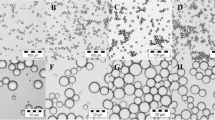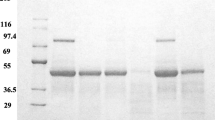Abstract
The present study sought to determine if alterations in the chemical nature and form of fat in food would reduce digestibility while maintaining acceptability in rats. Oil-in-water emulsions (d < 1 μm) were prepared with either liquid palm oil, solid hydrogenated palm oil or solid docosane, all stabilized with sodium caseinate. The emulsions were incorporated into a fat-free rodent feed, and each offered over 5 days to separate cohorts of 12 male Sprague–Dawley rats housed in metabolic cages. The feed formulated with solid hydrogenated palm oil was significantly less acceptable than the feeds containing either liquid palm oil or docosane (feed intake 4.9, 26.6 and 32.1 g/animal/day respectively). The proportion of the fat retained (i.e. absorbed) was significantly less in the animals consuming the feed formulated with solid docosane than in the animals consuming either the liquid or solid palm oil (retention 8.7, 99.6, and 97.2%, respectively). The appearance of the feces from the rats fed docosane was different from the rats fed the triacylglycerol samples and thermal analysis revealed many of the solid alkane droplets had not coalesced during passage through the rat’s digestive system. These results indicate that indigestible fats can be packaged into food in a manner that does not compromise the acceptability of the product, and does not produce any apparent intestinal distress.


Similar content being viewed by others
References
World Health Organization. Fact Sheet # 317, Cardiovascular Diseases Updated Sept 2009. http://www.who.int/mediacentre/factsheets/fs317/en/index.html. Accessed May 2010
Wolmarans P (2009) Background paper on global trends in food production, intake and composition. Ann Nutr Metab 55:244–272
Jandacek RJ, Kester JJ, Papa AJ, Wehmeier TJ, Lin PYT (1999) Olestra formulation and the gastrointestinal tract. Lipids 34:771–783
McRorie J, Zorich N, Riccardi K, Bishop L, Filloon T, Wason S, Giannella R (2000) Effects of olestra and sorbitol consumption on objective measures of diarrhea: impact of stool viscosity on common gastrointestinal symptoms. Reg Toxicol Pharm 31:59–67
Sandler (1999) Gastrointestinal symptoms in 3181 volunteers ingesting snack foods containing olestra or triglycerides: a 6-week randomized, placebo-controlled trial. Ann Inter Med 130:253–261
Apgar JL, Shively CA, Tarka SM (1987) Digestibility of cocoa butter and corn oil and their influence on fatty acid distribution in rats. J Nutr 117:660–665
Kaplan R, Greenwood CE (1998) Poor digestibility of fully hydrogenated soybean oil in rats: a potential benefit of hydrogenated fats and oils. J Nutr 128:875–880
Siletti E, Vingerhoeds MH, Van Aken GA, Norde W (2008) Rheological behavior of food emulsions mixed with saliva: effect of oil content, salivary protein content, and saliva type. Food Biophys 3:318–328
Sarkar A, Goh KKT, Singh RP, Singh H (2009) Behaviour of an oil-in-water emulsion stabilized by β-lactoglobulin in an in vitro gastric model. Food Hydrocolloids 23:1563–1569
Singh H, Yea A, Horne D (2009) Structuring food emulsions in the gastrointestinal tract to modify lipid digestion. Prog Lipid Res 48:92–100
Golding M, Wooster TJ (2010) The influence of emulsion structure and stability on lipid digestion. Curr Opin Colloid Interface Sci 15:90–101
Mun S, Decker EA, McClements J (2007) Influence of emulsifier type on in vitro digestibility of lipid droplets by pancreatic lipase. Food Res Int 40:770–781
Bonnaire L, Sandra S, Helgason T, Decker E, Weiss J, McClements D (2008) Influence of lipid physical state on the in vitro digestibility of emulsified lipids. J Agric Food Chem 56:3791–3797
Reed DR, Friedman MI (1990) Diet composition alters the acceptance of fat by rats. Appetite 14:219–230
Hager MH, Schneeman BO (1986) Pancreatic enzyme and plasma cholesterol response to chronic ingestion of a nonabsorbable lipid in rats. J Nutr 116:2372–2377
Hamilton CL (1964) Rats preference for high fat diets. J Comp Physiol Psychol 58:459–460
Mindell S, Smith GP, Greenberg D (1990) Corn oil and mineral oil stimulate sham feeding in rats. Physiol Behav 48:283–287
Carlisle HJ, Stellar E (1969) Caloric regulation and food preference in normal, hyperphagic, and aphagic rats. J Comp Physiol Psychol 69(1):107–114
Lucas F, Ackroff K, Sclafani A (1989) Dietary fat-induced hyperphagia in rats as a function of fat type and physical form. Physiol Behav 45:937–946
Mullen BJ, Martin RJ (1990) Macronutrient selection in rats: effect of fat type and level. J Nutr 120:1418–1425
Jackson CD, Weis C, Poirier LA, Bechtel DH (1996) Interactions of varying levels of dietary fat, carbohydrate, and fiber on food consumption and utilization, weight gain and fecal fat contents in female Sprague-Dawley rats. Nutr Res 16:1735–1747
Martins SV, Lopes PA, Alfaia CM, Rodrigues PO, Alves SP, Pinto RM, Castro MF, Bessa RJ, Prates JA (2010) Serum adipokine profile and fatty acid composition of adipose tissues are affected by conjugated linoleic acid and saturated fat diets in obese Zucker rats. Br J Nutr 103:869–878
Stachoń M, Fürstenberg E, Gromadzka-Ostrowska J (2006) Effects of high-fat diets on body composition, hypothalamus NPY, and plasma leptin and corticosterone levels in rats. Endocrine 30:69–74
Alessandri JM, Joannic JL, Delpal S, Durand G (1995) Effect of early dietary deficiency in polyunsaturated fatty acids on two lectin binding sites in the small intestine of postweanling rats. J Pediatr Gastroenterol Nutr 21:165–176
Angulo O (1995) Polyunsaturated fatty acid deficiencies: effects on hepatic plasma membrane fatty acid composition and enzyme activity. Arch Latinoam Nutr 45:295–304
Angulo-Guerrero O, Oliart RR (1998) Effects of dietary polyunsaturated fatty acids on rat brain plasma membrane fatty acid composition. Arch Latinoam Nutr 48:287–292
NRC (1995) Nutrient requirements of the laboratory rat. In: Nutrient Requirements of Laboratory Animals, 4th edn. National Academy Press, Washington, DC
Manorama R, Rukmini C (1991) Nutritional evaluation of crude palm oil in rats. Am J Clin Nutr 53:1031S–1038S
Granlund L, Larsen L, Christiansen E, Pedersen J (2000) Absorption of very-long-chain saturated fatty acids in totally hydrogenated fish oil. Br J Nutr 84:681–688
Rumpler WV, Baer DJ, Rhodes DG (1998) Energy available from corn oil is not different than that from beef tallow in high- or low-fiber diets fed to humans. J Nutr 128:2374–2382
Grompone MA (1991) Propiedades físicas y químicas de las grasas bovinas fraccionadas e interesterificadas. Grasas y Aceites 42:349–355
Vanapalli S, Palanuwech J, Coupland JN (2002) Influence of fat crystallization on the stability of flocculated emulsions. J Agric Food Chem 50:5224–5228
Coupland JN (2002) Crystallization in emulsions. Curr Opin Colloid Interface Sci 7:445–450
Acknowledgments
We are grateful to the Penn State College of Agricultural Sciences Seed grant program for supporting this work.
Author information
Authors and Affiliations
Corresponding author
About this article
Cite this article
Wang, Y., Corwin, R., Jaramillo, D.P. et al. Acceptability and Digestibility of Emulsions in a Rat Model: Effects of Solid Fat Content and Lipid Type. J Am Oil Chem Soc 88, 235–241 (2011). https://doi.org/10.1007/s11746-010-1671-1
Received:
Revised:
Accepted:
Published:
Issue Date:
DOI: https://doi.org/10.1007/s11746-010-1671-1




